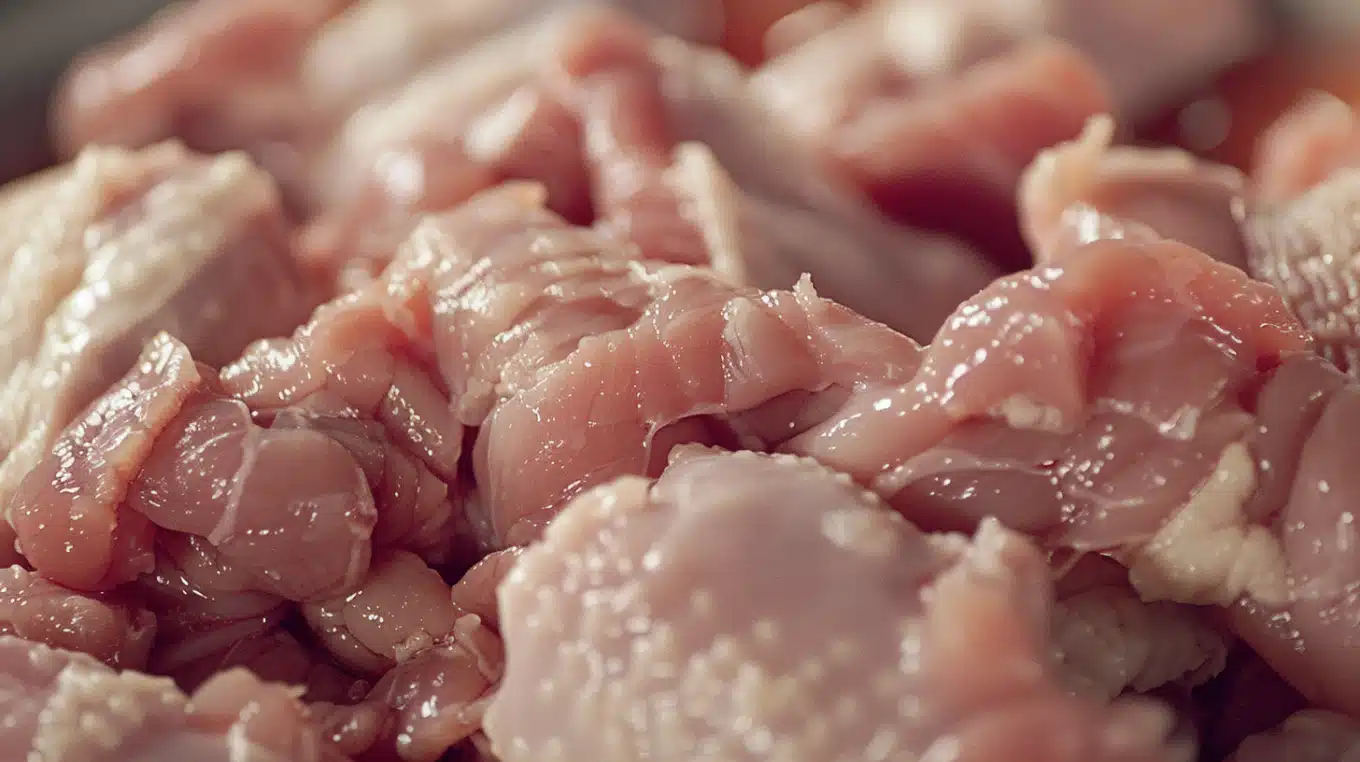Have you ever experienced the unpleasant smell of bad chicken?
It’s a common issue that many people face, and it can be concerning when you’re unsure about the safety and quality of your poultry.
The good news is that understanding the causes of foul odor in chicken can help you take the necessary steps to prevent it and ensure that your meals are delicious and safe to consume.
This blog post will explore why chicken might develop an off-putting smell and provide practical solutions to tackle this problem head-on.
By the end of this article, you’ll be equipped with the knowledge and tools to confidently handle and enjoy your chicken dishes without any unpleasant surprises.
Understanding the Basics of Chicken Spoilage
Chicken spoilage is the process by which fresh chicken goes bad due to the growth of tiny organisms like bacteria, chemical changes, and enzyme breakdown.
This degradation makes the chicken unsafe or unappetizing to eat.
Eating spoiled chicken can lead to food poisoning, which causes symptoms such as an upset stomach, throwing up, and loose stools.
Knowing the signs of spoilage is crucial to avoid these health problems.
Differentiation of Spoilage and Contamination
Spoilage (Smelly-Bad)
Spoiled chicken has distinct traits like unpleasant odors (sulfur, rotten eggs), a slimy feel, and color changes from pink to dull gray. While spoiled chicken is unappealing, thoroughly cooking it might prevent illness.
Contamination (Might Make You Sick Bad)
Contrastingly, contaminated chicken may look and smell normal but can cause serious foodborne illnesses. Harmful germs like Salmonella and E. coli can contaminate chicken without obvious signs.
Causes of Foul Odor in Chicken
Foul smells in chicken can come from biological activities, chemical reactions, and environmental factors.
Knowing these causes helps prevent spoilage and keep the chicken safe to eat.
1. Biological Causes
- Role of Bacteria: Bacteria are the main culprits behind chicken spoilage and contamination, leading to bad odors. They flourish in moist, nutrient-rich conditions.
- Types of Bacteria: Salmonella, Campylobacter, and E. coli are common bacteria that spoil poultry. They cause specific odors and physical changes like sour smells or a slimy feel.
2. Chemical Processes
- Chemical Reactions: As bacteria break down proteins and fats in chicken with their enzymes, they release stinky compounds like hydrogen sulfide and cadaverine.
- Impact of Bacterial Metabolism: Bacterial metabolic processes directly contribute to bad chicken odors. For example, breaking down amino acids produces ammonia.
3. External Factors Influencing Spoilage
- Temperature: Temperature plays a crucial role in bacterial growth. Between 40°F and 140°F (4°C to 60°C), bacteria multiply very quickly.
- Storage Methods and Packaging: Poor storage and packaging can speed up spoilage. Vacuum-sealing and refrigeration slow bacterial growth and prevent odors.
Detection of Spoiled Chicken: Sensory Indicators
Spotting spoiled chicken is key to avoiding health risks. Our senses are the first line of defense, followed by using safe practices.
- Smell: A strong, unpleasant smell is a major sign of spoilage. Sour, ammonia-like, or rotten odors point to bacterial activity and decay.
- Appearance: Fresh chicken should be light pink with white fat. Dull gray, green tints, or mold mean spoilage.
- Texture: Texture also indicates spoilage. Fresh chicken is firm and slightly moist, not slimy or sticky. A tacky or slimy feel signals bacterial growth.
Handling Spoiled Chicken

Knowing how to handle chicken that may be spoiled can greatly reduce health risks. If you suspect the chicken is spoiled, it’s safest to discard it immediately, especially if you notice:
- Mold: Any visible mold growth is a clear sign of spoilage.
- Odor: Persistent bad smells after washing indicate spoilage.
Cooking Tips
For chicken that might be contaminated but does not show visible signs of spoilage:
- Always cook chicken to an internal temperature of 165°F (74°C).
- Use a food thermometer to accurately check the temperature, ensuring all harmful bacteria are destroyed.
Safe Handling and Storage Practice
Choosing Fresh Chicken
When shopping for chicken, keep these pointers in mind:
- Color: Look for a healthy pink hue.
- Texture: The meat should feel firm, not soft or limp.
- Odor: There should be no strong or unpleasant smell.
- Freshness Indicators: Always check the ‘sell-by’ and ‘use-by’ dates to ensure maximum freshness.
Key Practices for Storage
- Use-by dates guide freshness. They show how long chicken stays at peak quality when stored right.
- Keep chicken cold (below 40°F/4°C)
- Seal and package well to avoid cross-contamination in the fridge
- Cook chicken to 165°F (74°C) to kill harmful bacteria
- Store chicken in the coldest part of your refrigerator.
- Avoid leaving chicken at room temperature for over two hours to prevent bacterial growth.
- Wrap chicken tightly in materials suitable for the freezer.
- Keep frozen at 0°F (-18°C) to preserve its quality and inhibit bacterial growth.
Conclusion
In conclusion, understanding the causes of foul odor in chicken is crucial for maintaining food safety and enjoying delicious meals.
By recognizing the signs of spoilage, such as unpleasant smells, discoloration, and slimy texture, you can make informed decisions about whether your chicken is safe to consume.
Proper storage, handling, and cooking techniques can significantly reduce the risk of bacterial growth and spoilage risk.
Remember, when in doubt, it’s always better to err on caution and discard any chicken showing signs of deterioration.
By staying vigilant and proactive, you can ensure that your chicken dishes are tasty and safe for you and your loved ones.
So, the next time you prepare a chicken meal, remember these tips for a worry-free and enjoyable cooking experience.




